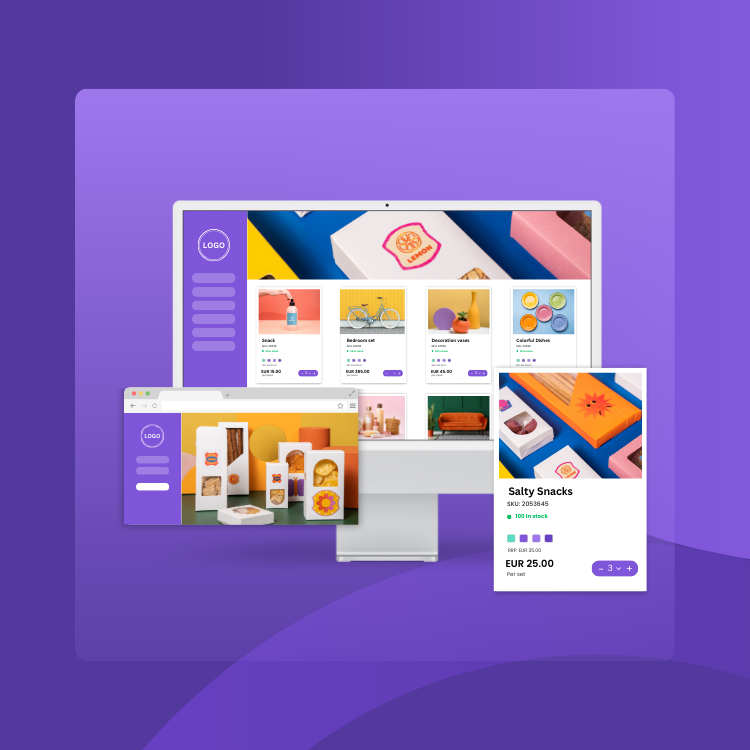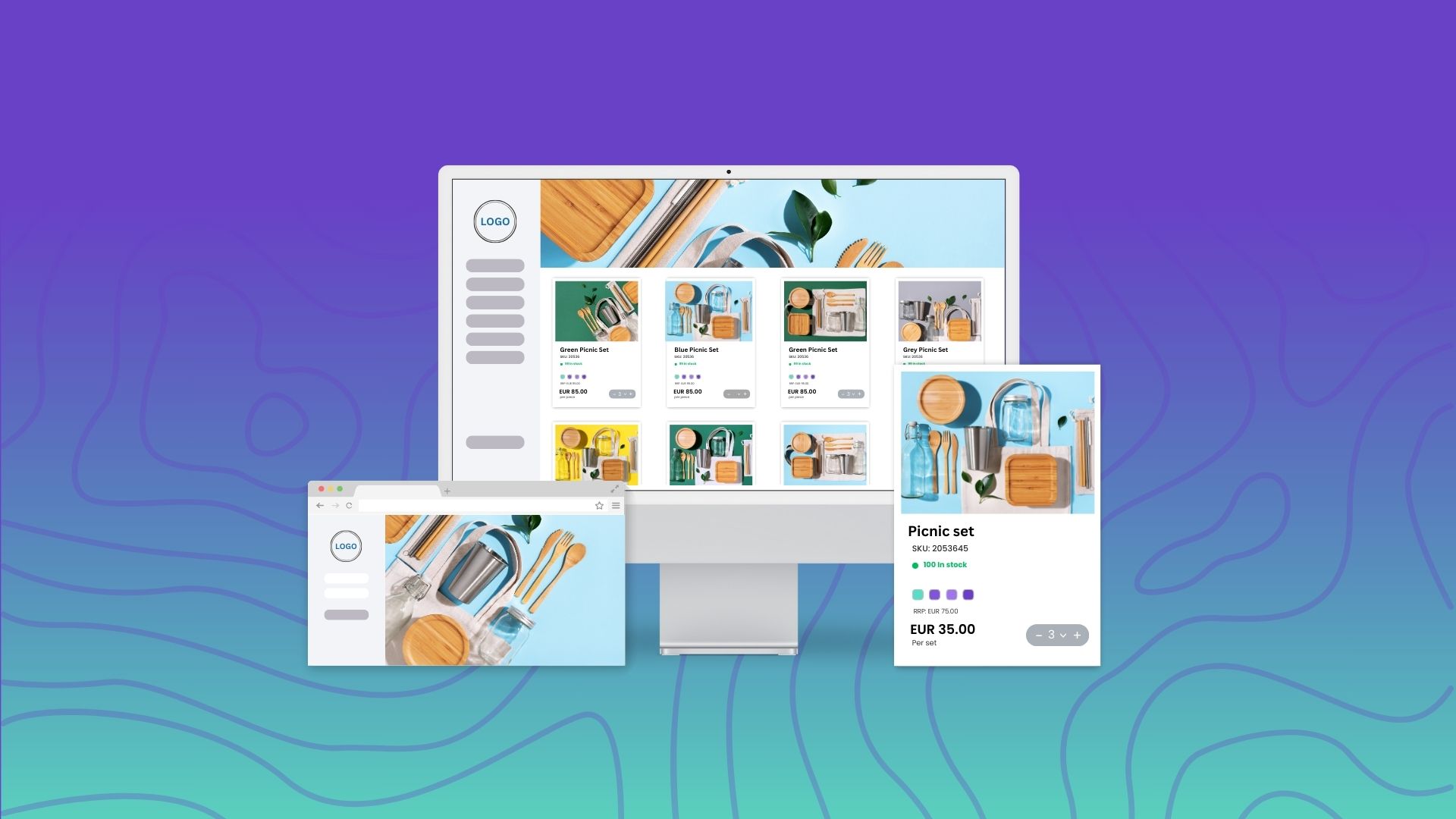How to kick-start a B2B eCommerce business in 7 easy steps: Guide 2024

Thinking about starting your own online store in 2024? You’re in the right place! The world of online shopping is not only exciting but also rife with opportunities for entrepreneurs like you.
Whether you’re new to the e-commerce scene or an experienced business owner aiming to expand your digital presence, our comprehensive guide is here to empower you with the knowledge and insights you need.
We’ll take you through the fundamentals of setting up your ecommerce venture in nine easy-to-follow steps. From choosing the right products to crafting a robust strategy for success, we’ve got you covered at every stage of your journey. Plus, discover how Turis, your trusted partner, can simplify the management of your B2B online store, making it a breeze to achieve your goals and aspirations. Let’s embark on this exciting path together!
Table of Contents
- Step 1: Find your niche in the B2B Ecommerce world
- Step 2: Write a business plan
- Step 3: Choose a business name and start building your brand
- Step 4: Register your business
- Step 5: Create your B2B eCommerce business website
- Step 6: Source and develop your products or services
- Step 7: Launch and market your B2B eCommerce business
- Related Posts
Step 1: Find your niche in the B2B Ecommerce world
Dive into the world of Ecommerce models
From the flexibility of dropshipping to the consistency of warehousing, the thrill of subscription services, and the innovation in digital products – explore the diverse ecommerce possibilities. Discovering these models is key to finding the perfect fit for your business vision and lifestyle. Keep in mind that each ecommerce model has its unique characteristics, advantages, and challenges, and the choice of model can significantly impact the strategy and operations of an ecommerce business.
B2C (Business-to-Consumer)
This is the most common ecommerce model. Businesses sell products or services directly to individual consumers. Examples include online retailers like Amazon or fashion stores like ASOS.
B2B (Business-to-Business)
In this model, businesses sell products or services to other businesses. This often involves bulk sales, specialized products, or services tailored for business needs. Examples include Alibaba and wholesale suppliers.
C2C (Consumer-to-Consumer)
Here, consumers sell directly to other consumers, often through online platforms or marketplaces like eBay or Etsy. This model includes second-hand sales, handmade goods, and vintage items.
C2B (Consumer-to-Business)
In this reverse model, individuals offer products or services to businesses. This can include freelance work, stock photography, or customer-generated marketing content.
Dropshipping
Retailers sell products without holding inventory. When a customer makes a purchase, the order is fulfilled and shipped directly from a third-party supplier. This model minimizes risk and investment for the retailer.
Subscription Services
Customers pay a recurring fee to access products or services. This model ensures steady revenue and customer retention. Examples include Netflix for entertainment or Blue Apron for meal kits.
White Label and Private Label
White label involves selling products produced by another company under your brand name, while private label refers to selling products manufactured exclusively for your brand. Both models allow customization and control over branding.
Marketplace
This model provides a platform for multiple sellers to offer products or services. The marketplace operator manages the platform and may process transactions, earning a commission or fees. Amazon Marketplace and Airbnb are examples.
Digital Products
This includes the sale of digital goods like ebooks, online courses, software, and digital assets. These products often have lower overhead costs and can be sold globally.
On-Demand Manufacturing
Products are made as orders are received, reducing the need for inventory. This model is often used in the apparel industry and by companies offering customized products.
Selecting a profitable B2B eCommerce niche
Identifying a niche that not only interests you but also has a profitable market demand is essential when creating the right foundation for a successful business. This includes researching trending products, understanding your potential customer base, and evaluating competition in the niche you’re considering.
Research Market Trends: Stay updated on current and emerging market trends. Use tools like Google Trends, social media, and industry reports to identify what products or services are gaining popularity.
Analyze Competitor Success: Look at competitors in potential niches. Note what they are doing well and areas where they may be lacking. This can reveal opportunities for differentiation.
Understand Your Audience: Knowing your target audience is crucial. Create detailed buyer personas to understand their needs, preferences, and pain points. Tailor your niche to address these specifics.

Evaluate Profitability: Assess the potential profitability of a niche. Consider factors like product pricing, supply costs, and the audience’s willingness to pay. Tools like SEMrush can help analyze keyword search volume and competition.
Check for Long-Term Viability: Avoid trends that may not last. Aim for a niche with long-term potential. Evergreen niches or those with a consistent track record of demand are often safer bets.
Leverage Your Passion and Expertise: Writing about a niche you’re passionate about or have expertise in can be more authentic and engaging. It also helps in creating quality content and building authority.
Consider Cross-Selling and Upselling Opportunities: A profitable niche often allows for related products or services. This can increase average order value and customer lifetime value.
Identify Unique Value Propositions (USPs): What can you offer that others don’t? This could be unique product features, exceptional customer service, or expertise in a specific area.
Use SEO and Keyword Research: Utilize SEO strategies and keyword research to ensure your content reaches the right audience. Targeted keywords related to your niche should be included in your website content, blogs, and product descriptions.
Engage with Your Audience: Use social media, forums, and customer feedback to engage with your audience. This can provide insights into their evolving needs and help refine your niche strategy.
Step 2: Write a business plan
Even if you’re starting your e-commerce business independently, a well-crafted business plan is essential. It helps you structure your thoughts, set clear goals, and develop a roadmap for success. A business plan is not just a formal document but a guide that keeps you focused and on track. It’s a living document that evolves as your e-commerce business grows. Here’s how to approach it:
Components of a solid eCommerce business plan
Executive Summary: This is a concise overview of your business concept. Include your business name, the products or services you’ll offer, and your mission statement. It should also briefly outline your vision and goals.
Market Analysis: Conduct research to understand your target market, identify your ideal customers, and analyze your competitors. This helps in defining your market position and understanding the potential demand for your products or services.
Products and Services: Describe in detail what you’re selling. Explain the features and benefits of your products or services, and why they’re needed in the market.
Marketing Plan: Develop a strategy for how you’ll attract and retain customers. This should include your branding strategy, marketing channels (like social media, content marketing, SEO), and customer engagement tactics.
Operations Plan: Outline the logistics of running your e-commerce business. This includes your supply chain, order fulfillment process, and the technology you’ll use (like e-commerce platforms, payment processors).
Financial Plan: Include a budget, pricing strategy, and financial projections. Even if you’re not seeking external funding, understanding your financials is crucial for making informed business decisions.
Goals and Strategies: Set short-term and long-term goals for your business. Outline specific strategies on how you plan to achieve these goals. This could include sales targets, customer acquisition strategies, or product expansion plans.
Setting goals and outlining strategies
SMART Goals: Set Specific, Measurable, Achievable, Relevant, and Time-bound goals to keep your business on track.
- Specific: Ensure your goals are clear, well-defined, and unambiguous.
- Measurable: Create goals that can be quantified or assessed to track progress.
- Achievable: Set realistic and attainable goals that can be accomplished.
- Relevant: Make sure your goals align with your business objectives and are meaningful.
- Time-bound: Define a timeframe or deadline for achieving your goals.
Adaptability: Be prepared to adapt your strategies based on market response and other external factors.

Continuous Improvement: Regularly review and update your business plan to reflect changes in the market and your business growth.
Step 3: Choose a business name and start building your brand
Choosing the right business name and building your brand are essential steps in establishing your ecommerce presence. These elements not only define your identity but also influence customer perception and loyalty.
Choosing a memorable business name
Reflect Your Offerings: Your business name should give a hint about what you sell or the service you provide. It aids in setting the right expectations.
Keep it Simple and Catchy: A name that’s easy to remember and pronounce can stick in customers’ minds. Avoid overly complex or lengthy names.
Check for Uniqueness: Research to ensure your chosen name isn’t already in use. This includes checking domain availability for your website.
Think Long-Term: Choose a name that won’t limit your business as it grows. Avoid overly specific names that might hinder expansion into other product lines or markets.
Cultural Sensitivity: Ensure the name doesn’t have unintended meanings or connotations in different cultures, especially if you plan to operate internationally.
Basics of brand building and identity
Define your brand personality: What is the personality of your brand? Is it professional, playful, innovative, or something else? This will influence your tone, messaging, and visual identity.
Create a strong visual identity: This includes your logo, color scheme, and typography. These elements should be consistent across all platforms and marketing materials.
Develop your brand voice: How you communicate with your audience – whether through website copy, social media posts, or customer service – should reflect your brand personality.
Build an online presence: In today’s digital world, having a strong online presence is essential. This includes a professional website, active social media profiles, and possibly a blog.
Consistency is key: Ensure consistency in how your brand is presented across different channels. This helps in building recognition and trust.
Engage with your audience: Build relationships with your customers through engagement. This could be through social media, email newsletters, or community involvement.
Feedback and adaptation: Listen to customer feedback and be willing to adapt. This shows that you value customer input and are committed to continuous improvement.
By thoughtfully choosing your business name and diligently building your brand, you set a solid foundation for your ecommerce business. These steps are crucial in differentiating yourself in the market and establishing a lasting connection with your customers.
Step 4: Register your business
Registering your ecommerce business is a critical step to ensure legal compliance and protect your brand. This process not only formalizes your business in the eyes of the law but also establishes your credibility in the marketplace, making it easier to build trust with suppliers and customers alike.
Understanding legal requirements
- Research local regulations: Laws for registering a business can vary significantly depending on your location. It’s important to research the specific legal requirements in your city, state, or country.
- Obtain necessary permits and licenses: Depending on your ecommerce activities, certain permits or licenses may be required. These could relate to sales tax, home business operations, or specific product categories.
- Register for taxes: Determine the tax obligations for your ecommerce business, including sales tax registration if applicable.
Choosing the right business structure
- Sole proprietorship: Suitable for small, low-risk businesses. This structure is simple to set up but doesn’t offer personal liability protection.
- Partnership: Ideal for businesses with multiple owners. Remember that like sole proprietorships, partnerships don’t provide personal liability protection.
- Limited liability company (LLC): Offers personal liability protection and has tax benefits. Suitable for business owners who want to protect their personal assets.
- Corporation (C-Corp or S-Corp): Suitable for businesses that plan to go public or seek funding from venture capitalists. Offers liability protection but comes with more regulatory requirements.
Tips for registration
Registering your business not only keeps you compliant with the law but also enhances your credibility with customers and partners. It’s a foundational step in establishing your business’s legal identity and paving the way for future growth.
Name your business: Ensure the name you chose in Step 3 is available for registration. You may also need to file a “Doing Business As” (DBA) name.
Prepare documentation: Prepare and file the necessary paperwork, which can usually be done online through your local government website.
Consult professionals: Consider consulting with a legal expert or accountant to make sure you’re covering all bases, especially if you’re unsure about the best structure for your business or have complex legal questions.
Step 5: Create your B2B eCommerce business website
A well-designed ecommerce website is essential for showcasing your products, engaging with customers, and driving sales. Here’s how to get started:
Selecting the right eCommerce platform
Choose the right eCommerce Platform: When choosing an ecommerce platform, consider Turis for its robust features tailored for B2B businesses. Key benefits include no-code customization, easy bulk order management, and flexible pricing options, making it ideal for growing businesses seeking a user-friendly and scalable solution.
Evaluate features and scalability: Look for platforms that offer the features you need, such as inventory management, payment processing, and integration with other tools. Also, consider how well the platform can scale as your business grows.
Consider costs and support: Understand the pricing structure of each platform and what level of customer support they offer. This can be crucial for resolving any issues quickly and efficiently.
Designing a user-friendly B2B eCommerce website
Creating your ecommerce website is a significant step in your online business journey. By choosing the right platform like Turis and focusing on user-friendly design and functionality, you can build a strong online presence that effectively supports your sales and marketing efforts.
Visual appeal: Your website’s design should reflect your brand identity. Use consistent branding elements like colors, logos, and typography. High-quality images and videos can also enhance the appeal of your website.
Content and SEO optimization: Develop engaging and informative content that resonates with your audience. Ensure your website is optimized for search engines (SEO) to improve visibility and attract more traffic.
Security and privacy: Implement robust security measures to protect customer data. This includes using secure sockets layer (SSL) encryption and complying with privacy laws and regulations.

User experience (UX) design: Focus on creating a website that is easy to navigate and pleasant to use. This includes having a clear menu structure, intuitive shopping cart processes, and responsive design for mobile users.
Analytics and optimization: Utilize analytics tools to track website performance and user behavior. Use these insights to continuously optimize your website for better user engagement and conversion rates.
Step 6: Source and develop your products or services
In this critical phase, you’ll decide where your products come from and how they’ll be developed to meet your customers’ needs.
Methods of sourcing products
Direct from Manufacturers: Working directly with manufacturers can offer competitive pricing and opportunities for customization. It requires more upfront work in terms of establishing relationships and ensuring quality control.
Wholesale suppliers: Purchasing from wholesalers is a straightforward way to stock popular items. It’s less time-consuming than manufacturing but offers less control over product uniqueness.
Dropshipping: A low-risk option where products are shipped directly from the supplier to the customer. Ideal for those who want to avoid handling inventory or have limited storage space.
Craft and artisan sources: Partnering with artisans or local producers can give your store a unique edge, especially if you’re focusing on handmade or niche products.
International sourcing: Importing goods can diversify your product range, but it’s essential to understand the complexities of customs, shipping logistics, and import taxes.
Considerations for product development
Sourcing and developing your products or services thoughtfully can set the foundation for your ecommerce business’s success. These steps ensure that you’re not just filling your store with products, but you’re strategically selecting and creating items that will resonate with your target audience and establish your brand in the marketplace.
Market research: Thoroughly understand your target audience’s preferences. Identify gaps in the current market that your products could fill.
Quality assurance: Establish stringent quality checks. Ensure your products meet relevant standards and regulations, especially if you’re in a highly regulated industry like food or healthcare.
Cost management: Keep a close eye on the cost of production and how it impacts your pricing strategy. It’s vital to strike a balance between quality and affordability.
Sustainability: Consider the environmental impact of your products. Sustainable practices can be a significant draw for today’s eco-conscious consumers.
Prototype testing: Before mass production, create prototypes and gather feedback. This step can save significant resources by ensuring product-market fit.
Packaging design: Invest in packaging that is not only protective but also aligns with your brand identity. Good packaging can significantly enhance customer experience and brand perception.
Step 7: Launch and market your B2B eCommerce business
Launching your ecommerce business is an exciting milestone. It’s more than just making your website live – it’s about creating buzz and drawing in your first customers. Here’s how to prepare for the launch and market your business effectively.
Preparing for the launch
- Final website checks: Ensure your website is fully functional – test navigation, checkout processes, and mobile compatibility.
- Inventory preparation: Make sure you have enough stock to meet anticipated demand. Avoid overstocking, but have enough to fulfill initial orders.
- Set up customer service: Have a system in place to handle customer inquiries and issues. This could be via email, chat support, or phone.
- Create a launch plan: Plan a launch event or promotion to create excitement. This could include special offers, a launch countdown on social media, or an email blast to potential customers.

Effective eCommerce marketing strategies
Launching and marketing your ecommerce business require careful planning and execution. By preparing thoroughly for the launch and employing a mix of marketing strategies, you can effectively attract and retain customers, setting the stage for long-term success.
Search Engine Optimization (SEO): Optimize your website for search engines to improve visibility. Focus on keyword research, quality content, and on-page SEO techniques.
Social Media Marketing: Utilize platforms like Facebook, Instagram, and LinkedIn to build your brand presence. Post engaging content, interact with your audience, and use targeted ads to reach potential customers.
Email Marketing: Build an email list and start an email marketing campaign. Use it for sending newsletters, exclusive offers, and product updates to keep your audience engaged.
Content Marketing: Create valuable content like blogs, videos, and infographics that can attract and educate your audience, while also improving your SEO efforts.
Influencer Partnerships: Collaborate with influencers in your niche to reach a broader audience. Choose influencers whose followers match your target market.
Pay-Per-Click (PPC) Advertising: Invest in PPC campaigns on platforms like Google Ads or social media to drive traffic and sales. Start with a small budget and scale based on performance.
Analytics and Adaptation: Use analytics tools to track the performance of your marketing strategies. Be prepared to adapt your tactics based on what the data shows.
Other resources:
- Learn how to make your goals SMART
- 14 tips on how to find wholesale suppliers in 2024
- 33 Essential Ecommerce Marketing Tools to Skyrocket Your Business (Includes Free & Premium Options)
- Top 12 Logo Design Tools: Find Your Perfect Match for Creating an Unforgettable Logo


